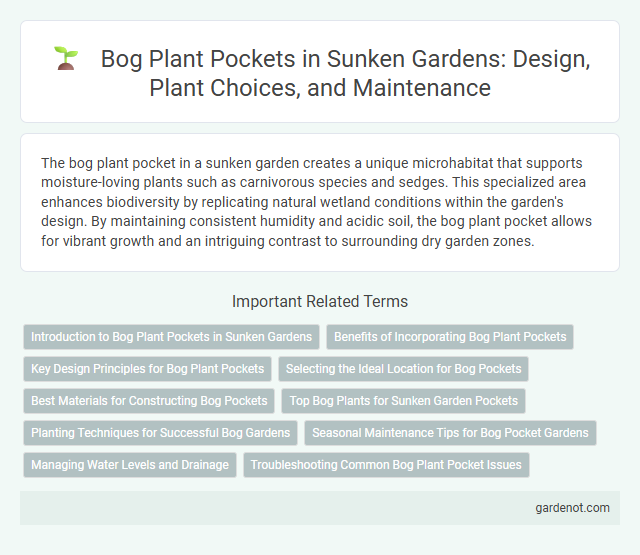The bog plant pocket in a sunken garden creates a unique microhabitat that supports moisture-loving plants such as carnivorous species and sedges. This specialized area enhances biodiversity by replicating natural wetland conditions within the garden's design. By maintaining consistent humidity and acidic soil, the bog plant pocket allows for vibrant growth and an intriguing contrast to surrounding dry garden zones.
Introduction to Bog Plant Pockets in Sunken Gardens
Bog plant pockets in sunken gardens create specialized microhabitats that mimic natural wetland conditions, supporting moisture-loving plants such as carnivorous species, sedges, and ferns. These pockets improve biodiversity by providing a water-retentive environment within otherwise well-drained garden beds, enhancing the ecological balance. Strategic placement and engineered soil composition enable optimal drainage and moisture retention critical for bog plant survival and growth in sunken garden settings.
Benefits of Incorporating Bog Plant Pockets
Bog plant pockets enhance sunken gardens by improving water retention and creating microhabitats for moisture-loving species. They support biodiversity by attracting amphibians, insects, and specialized plants adapted to wet conditions. Integrating these pockets also aids in natural water filtration and reduces soil erosion, contributing to a healthier garden ecosystem.
Key Design Principles for Bog Plant Pockets
Bog plant pockets require careful selection of moisture-retentive soils combined with excellent drainage to prevent waterlogging while maintaining consistent hydration. Incorporating native bog plants like Sarracenia and Iris ensures ecological balance and resilience in wet conditions. Strategic layering with organic matter and sand enhances aeration and nutrient availability, promoting healthy root development.
Selecting the Ideal Location for Bog Pockets
Choosing the ideal location for bog plant pockets involves selecting areas with consistent moisture and partial shade to mimic natural bog conditions. Positioning bog pockets near water features or in low-lying garden spots ensures adequate hydration and supports moisture-loving species like carnivorous plants and sedges. Proper site selection enhances plant health and promotes robust growth in sunken garden settings.
Best Materials for Constructing Bog Pockets
The best materials for constructing bog plant pockets include high-quality pond liner or heavy-duty polypropylene fabric to retain moisture and prevent soil erosion. Using a mixture of sphagnum moss and organic compost creates an ideal growing medium that maintains consistent hydration and provides essential nutrients. Incorporating a layer of gravel or small stones at the base ensures proper drainage, preventing waterlogging while supporting healthy root development.
Top Bog Plants for Sunken Garden Pockets
Top bog plants for sunken garden pockets include varieties like Carex, Lobelia, and Sarracenia, which thrive in consistently moist, acidic soil. These plants provide lush textures and vibrant colors, enhancing the unique microhabitat of a sunken garden. Selecting species adapted to bog conditions ensures healthy growth and a sustainable, visually appealing pocket garden.
Planting Techniques for Successful Bog Gardens
Planting techniques for successful bog gardens involve selecting moisture-loving bog plant pockets that thrive in consistently wet, acidic soil conditions. Ensuring proper layering with a base of organic matter such as peat moss or sphagnum helps retain moisture while providing essential nutrients. Strategic spacing and mulching around plants improve aeration and reduce evaporation, promoting healthy root development in bog environments.
Seasonal Maintenance Tips for Bog Pocket Gardens
Seasonal maintenance for bog plant pockets involves regular water level monitoring to ensure consistently moist soil, crucial for the health of moisture-loving species like marsh marigolds and skunk cabbage. Removing dead or yellowing foliage in early spring promotes new growth and prevents fungal diseases common in damp environments. Mulching with organic material during autumn preserves soil moisture and insulates roots against temperature fluctuations, supporting robust bog garden ecosystems year-round.
Managing Water Levels and Drainage
Effective management of water levels in a bog plant pocket involves maintaining consistently moist soil conditions to support bog-specific vegetation such as Sphagnum moss and carnivorous plants. Installing adjustable drainage systems allows precise control of water saturation, preventing waterlogging and promoting healthy root oxygenation. Regular monitoring and timely adjustment of water input ensure an optimal environment for plant growth and prevent issues related to stagnant water.
Troubleshooting Common Bog Plant Pocket Issues
Bog plant pocket issues often arise from poor drainage and inconsistent moisture levels, leading to root rot or wilting. Inspecting soil composition for adequate peat and sand ratios helps maintain optimal water retention and aeration. Regularly removing debris and monitoring pH levels between 5.5 and 6.5 prevents fungal growth and promotes healthy bog plant development.
Bog plant pocket Infographic

 gardenot.com
gardenot.com